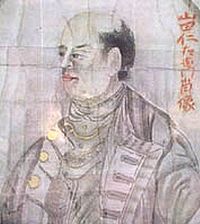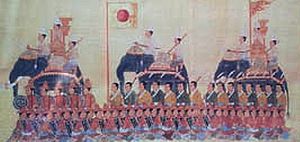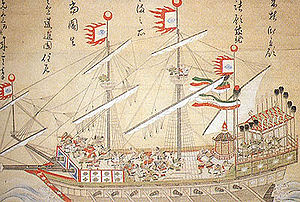- Yamada Nagamasa
-
Yamada Nagamasa 
Portrait of Yamada Nagamasa c. 1630.Born 1590
Numazu, JapanDied 1630 Allegiance  Japan
Japan
 Thailand
ThailandRank Ok-ya Senaphimuk (Thai: ออกญาเสนาภิมุข) Yamada Nagamasa (山田 長政, 1590–1630) was a Japanese adventurer who gained considerable influence in Ayutthaya kingdom at the beginning of the 17th century and became the governor of the Nakhon Si Thammarat in southern Thailand.
Yamada Nagamasa was born in Numazu in 1590. He is said to have been a palanquin bearer of the lord of Numazu. He became involved in Japanese trade activities with South-East Asia during the period of the Red seal ships and settled in the kingdom of Ayutthaya (modern-day Thailand) from around 1612.
Contents
Japanese settlement in southeast Asia
Yamada Nagamasa lived in the Japanese quarters of Ayutthaya, home to another 1,500 Japanese inhabitants (some estimates run as high as 7,000). The community was called "Ban Yipun" in Thai, and was headed by a Japanese chief nominated by Thai authorities. It seems to have been a combination of traders, Christian converts who had fled their home country following the persecutions of Toyotomi Hideyoshi and Tokugawa Ieyasu, and unemployed former samurai who had been on the losing side at the battle of Sekigahara:
From the years of Gen'na (1615–24) through the later years of Kan'ei (1624–44), the Ronin or warriors who lost their lords after the defeats of the battle of Osaka (1614–15) or the earlier battle of Sekigahara (1600), as well as the defeated Christians of the Shimabara uprising, went to settle in Siam in great numbers— Senrakoku Fudo-gunki, 17th century, quoted by Uchida GinzoThe Christian community seems to have been in the hundreds, as described by Padre Antônio Francisco Cardim, who recounted having administered sacrament to around 400 Japanese Christians in 1627 in the Thai capital of Ayuthaya ("a 400 japoes christaos").[1]
The colony was active in trade, particularly in the export of deer-hide to Japan in exchange for Japanese silver and Japanese handicrafts (swords, lacquered boxes, high-quality papers). They were noted by the Dutch for challenging the trade monopoly of the Dutch East India Company (VOC). The colony also had an important military role in Thailand. Yamada Nagamasa is alleged to have carried on the business of a corsair or pirate from the period of 1620, attacking and plundering Dutch ships in and around Batavia (present day Jakarta). Stories of Yamada burying his treasure on the East Coast of Australia persist but it is highly unlikely that Yamada would have ventured along the east coast of Australia and, in particular, Magnetic Island off Townsville, as there were no trade routes in this region and the only ships to venture to this region were the ones blown off course during the summer storms. This is speculative, however: Yamada would have passed thousands of islands in the Torres Straits and Coral sea and these would have provided safe keeping for any treasure and avoided a very long recovery voyage in the future.
Military involvement and lordship
The Japanese colony was highly valued for its military expertise, and was organized under a "Department of Japanese Volunteers" (Krom Asa Yipun) by the Thai king.
In the space of fifteen years, Yamada Nagamasa rose from the low Thai nobility rank of Khun to the senior of Ok-ya, his title becoming Ok-ya Senaphimuk (Thai : ออกญาเสนาภิมุข). He became the head of the Japanese colony, and in this position supported the military campaigns of the Thai king Songtham, at the head of a Japanese army flying the Japanese flag. He fought successfully, and was finally nominated Lord of Ligor (modern Nakhon Si Thammarat), in the southern peninsula in 1630, accompanied by 300 samurai.
Travels between Siam and Japan
After more than twelve years in Siam, Yamada Nagamasa went to Japan in 1624 onboard one of his ships, where he sold a cargo of Siamese deer hide in Nagasaki. He stayed in Japan for three years, trying to obtain a Red Seal permit, but finally left in 1627, with the simple status of a foreign ship.
In 1626, Nagamasa offered a painting of one of his fighting ships to a temple of his hometown in Shizuoka. That painting was lost in a fire, but a copy of it remains to this day (shown here). It portrays a ship with Western-style rigging, 18 cannons, and sailors in samurai gear. He returned to Siam in 1627.
In 1628, one of his ships transporting rice from Ayutthaya to Malacca was arrested by a Dutch warship blockading the city. The ship was released once the identity of the owner became clear, since the Dutch knew that Yamada was held in great respect by the King of Siam, and they did not wish to enter into a diplomatic conflict. Yamada was also valued by the Dutch as a supplier of deer hide, and they invited him to trade more with Batavia (Accounts of the castle of Batavia, March 1, 1628).
In 1629, Yamada Nagamasa visited Japan with an embassy from the Thai king Songtham.
He soon travelled back to Siam, but became involved in a succession war following the death of the King Songtham. He was wounded in combat in 1630, and then apparently poisoned through his wound, which led to his death.
End of relations between Siam and Japan
Following Yamada's death in 1630, the new ruler and usurper king of Siam Prasat Thong (1630–1655) sent an army of 4000 soldiers to destroy the Japanese settlement in Ayutthaya, but many Japanese managed to flee to Cambodia. A few years later in 1633, returnees from Indochina were able to re-establish the Japanese settlement in Ayutthaya (300-400 Japanese).
From 1634, the Shogun, informed of these troubles and what he perceived as attacks on his authority, refused to issue further Red Seal ship permits for Siam.
Desirous to renew trade however, the king of Siam sent a trading ship and an embassy to Japan in 1636, but the embassies were rejected by the Shogun, thus putting an end to direct relations between Japan and Siam. Japan was concomitantly closing itself to the world at that time, initiating the "Closed Country", or Sakoku, period.
The Dutch took over the lucrative Siam-Japan trade from that time on.
Nagamasa now rests in his hometown in the area of Otani. The remnants of the Japanese quarters in Ayutthuya are still visible to visitors, as well as a statue of Yamada in Siamese military uniform.
Film adaptations
- The Gaijin (山田長政 王者の剣) - 1959
- Yamada: The Samurai of Ayothaya - 2010
See also
References
- ^ Ishii Yoneo, Multi-cultural Japan.
- "Red seal ships." Nagazumi Yoko, Japanese (朱印船、永積洋子) ISBN 4-642-06659-4.
- "Multicultural Japan" Cambridge University Press, ISBN 0-521-00362-8
- "Samurai of Ayutthaya: Yamada Nagamasa, Japanese Warrior and Merchant in Early 17th Century Siam". Cesare Polenghi, Lotus Press, 2009, ISBN 978-974-480-147-0
Categories:- 1590 births
- 1630 deaths
- Deaths by poisoning
- Expatriates in Thailand
- History of the foreign relations of Japan
- Japanese explorers
- People from Numazu
Wikimedia Foundation. 2010.


